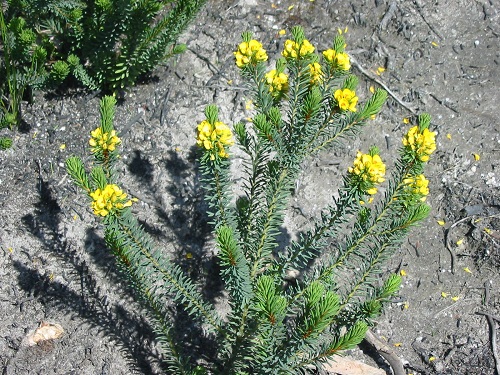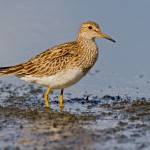
The Swamp Bush-pea is usually found in small numbers around Kinglake and Bunyip. Image: Arn Tolsma
The 2009 bushfires in Victoria triggered a population explosion for a number of rare plant species.
The Swamp Bush-pea (Pultenaea weindorferi), is a threatened shrub species, found in drainage lines and swamps around Kinglake and Bunyip. This species has had a spectacular response to the Black Saturday bushfires in 2009, with one patch of the burnt area in Bunyip State Park now estimated to contain 250,000 plants.
Researchers from the Department of Sustainability and Environment’s Arthur Rylah Institute (ARI) have investigated the responses of a wide range of threatened plant species, including the Swamp Bush-pea, to the 2009 bushfires. ARI Scientist Arn Tolsma said that it is possible that the Swamp Bush-pea population has increased from a few thousand plants to millions following the fires.
“In some areas the populations have only been a few dozen plants scattered across a few hectares,” he said. “There certainly has been a big explosion. Everywhere we went we’d see thousands of them.”
The number of Swamp Bush-peas in these areas may be influenced by the number of fire events, with more Swamp peas indicating a recent fire event in the area. “If you have more fires, you have potentially more germination events,” Dr Tolsma said.
“But if they are too close together you may wipe these shrubs out by destroying the seed source.”
Other species populations, such as the Southern Varnish Wattle and the Gully Grevillea, have also increased dramatically after the fires. Before the 2009 bushfires, the Southern Varnish Wattle was only present in small numbers, but researchers have now noted over 100,000 plants in a few hectares near Kinglake.
Many native species have hard seeds that germinate when stimulated by heat or smoke from bushfires. This can be affected by the intensity of the fires- a low intensity fire, such as a controlled hazard reduction burn, may not be enough to trigger germination.
By determining the life traits of rare Australian plant species, the researchers can better manage native forests and fire regimes, which are predicted to intensify as a result of climate change.”We made a deliberate decision to go and look what’s happening to all the rare populations,” Dr Tolsma said.
“For a lot of these species we don’t know what the response to fire is.”
However, Dr Tolsma said this prolific response of the Swamp Bush-pea population to the bushfires won’t change its Threatened status. In the absence of another fire event, other native species will have crowded them out in 20-30 years.
The older surviving plants will begin to die off, causing population numbers to decrease again. The seed banks will remain buried in the soil, ready to sprout again after another fire event.






